main |
sidebar
 As you may be aware oil painting was for a long time considered to be one of the highest forms of artistic expression. The rich texture and vibrant colors of oil paints provided enormous scope for the artist to express his or her talent. Oil painting continues to be a form of art that is complex and yet exuberant.
As you may be aware oil painting was for a long time considered to be one of the highest forms of artistic expression. The rich texture and vibrant colors of oil paints provided enormous scope for the artist to express his or her talent. Oil painting continues to be a form of art that is complex and yet exuberant.
The materials needed for oil paintings and the complex processes involved in creating classical oil painting made it prohibitively expensive. It is therefore not surprising that, until recently oil paintings could be bought and appreciated only by the aristocratic people. The expensive process of creating an oil painting made it often impossible for a common man to commission a work of art or, for that matter, even to gaze at and appreciate one. It is only lately that due to the emergence of public museums and galleries the general public has access to oil paintings. Nevertheless, buying or possessing an oil painting continues to be a symbol of opulence. But the scenario is now gradually changing and buying oil paintings is becoming affordable.
 Escher constructed a five-sided chamber in which all sides are interchangeable. This is his first print to focus primarily on his idea of relativity, how one object is seen in relation to another. The Islamic figurine of a harpy, a mythical creature with a bird's body and a human head, was a gift from Escher's father-in-law and appears in several of his paintings.
Escher constructed a five-sided chamber in which all sides are interchangeable. This is his first print to focus primarily on his idea of relativity, how one object is seen in relation to another. The Islamic figurine of a harpy, a mythical creature with a bird's body and a human head, was a gift from Escher's father-in-law and appears in several of his paintings.
The difference between a wood engraving, shown here, and a woodcut is that the wood used in a wood engraving is cut across the grain and not along it. In this way the wood is less likely to splinter and can be worked like a copper plate with a burin. Wood engraving allows for greater detail and more delicate effects.
 Escher wrote that this print "gives the illusion of a town, of house blocks with the sun shining on them. But again it's a fiction, for my paper remains flat. Escher was famous for his oil paintings, and other fine art gallery reproductions during his school days itself. In a spirit of deriding my vain efforts and trying to break up the paper's flatness, I pretend to give it a blow with my fist at the back, but once again it's no good: the paper remains flat, and I have only created the illusion of an illusion. However, the consequence of my blow is that the balcony in the middle is about four times enlarged in comparison with the bordering objects."
Escher wrote that this print "gives the illusion of a town, of house blocks with the sun shining on them. But again it's a fiction, for my paper remains flat. Escher was famous for his oil paintings, and other fine art gallery reproductions during his school days itself. In a spirit of deriding my vain efforts and trying to break up the paper's flatness, I pretend to give it a blow with my fist at the back, but once again it's no good: the paper remains flat, and I have only created the illusion of an illusion. However, the consequence of my blow is that the balcony in the middle is about four times enlarged in comparison with the bordering objects."
 This is one of Escher's earliest prints to explore different levels of reality. The first observed reality is the mirror itself and the objects that surround it. The second is that of the street, which in turn becomes part of the room by its reflection in the mirror.
This is one of Escher's earliest prints to explore different levels of reality. The first observed reality is the mirror itself and the objects that surround it. The second is that of the street, which in turn becomes part of the room by its reflection in the mirror.
Finally, the objects in front of the mirror, by their reflection, become part of the street scene. At the same time the print presents a physical impossibility: the mirror is tilted toward the ceiling yet reflects the view of the street from the window on the opposite wall.
 Escher often used his drawings such as oil paintings, fine art gallery as studies for prints, but he occasionally also experimented with various drawing techniques. His most important experiments are the "scratch drawings" for which he evenly coated the paper with lithographic drawing ink. He then drew on the prepared surface with a pointed tool, scoring or scratching into it to produce his image. This technique, which he first employed in 1929, led Escher directly to his work in lithography.
Escher often used his drawings such as oil paintings, fine art gallery as studies for prints, but he occasionally also experimented with various drawing techniques. His most important experiments are the "scratch drawings" for which he evenly coated the paper with lithographic drawing ink. He then drew on the prepared surface with a pointed tool, scoring or scratching into it to produce his image. This technique, which he first employed in 1929, led Escher directly to his work in lithography.
 In May and June 1929 Escher traveled through the mountainous landscape of Abruzzi, Italy, planning to produce an illustrated book on the region. This never materialized, but he did create 28 drawings on oil paintings, fine art reproductions, oil paintings reproductions which he based prints, including this lithograph depicting the town of Castrovalva.
In May and June 1929 Escher traveled through the mountainous landscape of Abruzzi, Italy, planning to produce an illustrated book on the region. This never materialized, but he did create 28 drawings on oil paintings, fine art reproductions, oil paintings reproductions which he based prints, including this lithograph depicting the town of Castrovalva.
The Dutch artist Maurits C. Escher (1898-1972) was a draftsman, book illustrator, tapestry designer, and muralist, but his primary work was as a printmaker. Born in Leeuwarden, Holland, the son of a civil engineer, Escher spent most of his childhood in Arnhem. Aspiring to be an architect, Escher enrolled in the School for Architecture and Decorative Arts, original oil paintings in Haarlem. While studying there from 1919 to 1922, his emphasis shifted from architecture to drawing oil paintings and printmaking upon the encouragement of his teacher Samuel Jessurun de Mesquita. In 1924 Escher married Jetta Umiker, and the couple settled in Rome to raise a family. They resided in Italy until 1935, when growing political turmoil forced them to move first to Switzerland, then to Belgium. In 1941, with World War II under way and German troops occupying Brussels, Escher returned to Holland and settled in Baarn, where he lived and worked until shortly before his death.
 From December 1925 to March 1926 Escher worked on a series of six woodcuts on the theme of the Creation. This one depicts the division of sky and water. A Dutch educational association bought 300 impressions of this oil paintings woodcut to hang in public schools.
From December 1925 to March 1926 Escher worked on a series of six woodcuts on the theme of the Creation. This one depicts the division of sky and water. A Dutch educational association bought 300 impressions of this oil paintings woodcut to hang in public schools.
Escher spent the early part of the summer of 1931 in Ravello and along the coast of Amalfi, Italy. With its dramatic mountains and ancient hill towns this was a particularly favorite region for Escher. Oil Paintings Drawings from the trip, including this example, inspired 15 woodcuts, wood engravings, and lithographs.
 Created while Escher was still a student at the School for Architecture and Decorative Arts, Oil paintings reproductions in Haarlem, this is the first print to demonstrate his theory of the regular division of a plane. Escher cut eight heads -- four male and four female -- in the original wood block. The final image was achieved by printing the block four times.
Created while Escher was still a student at the School for Architecture and Decorative Arts, Oil paintings reproductions in Haarlem, this is the first print to demonstrate his theory of the regular division of a plane. Escher cut eight heads -- four male and four female -- in the original wood block. The final image was achieved by printing the block four times.
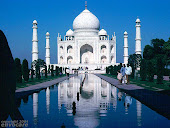
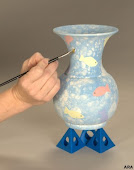


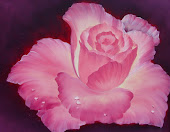
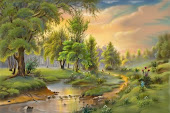


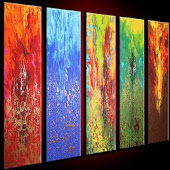

Wednesday, December 31, 2008
 As you may be aware oil painting was for a long time considered to be one of the highest forms of artistic expression. The rich texture and vibrant colors of oil paints provided enormous scope for the artist to express his or her talent. Oil painting continues to be a form of art that is complex and yet exuberant.
As you may be aware oil painting was for a long time considered to be one of the highest forms of artistic expression. The rich texture and vibrant colors of oil paints provided enormous scope for the artist to express his or her talent. Oil painting continues to be a form of art that is complex and yet exuberant.The materials needed for oil paintings and the complex processes involved in creating classical oil painting made it prohibitively expensive. It is therefore not surprising that, until recently oil paintings could be bought and appreciated only by the aristocratic people. The expensive process of creating an oil painting made it often impossible for a common man to commission a work of art or, for that matter, even to gaze at and appreciate one. It is only lately that due to the emergence of public museums and galleries the general public has access to oil paintings. Nevertheless, buying or possessing an oil painting continues to be a symbol of opulence. But the scenario is now gradually changing and buying oil paintings is becoming affordable.
Friday, December 26, 2008
 Escher constructed a five-sided chamber in which all sides are interchangeable. This is his first print to focus primarily on his idea of relativity, how one object is seen in relation to another. The Islamic figurine of a harpy, a mythical creature with a bird's body and a human head, was a gift from Escher's father-in-law and appears in several of his paintings.
Escher constructed a five-sided chamber in which all sides are interchangeable. This is his first print to focus primarily on his idea of relativity, how one object is seen in relation to another. The Islamic figurine of a harpy, a mythical creature with a bird's body and a human head, was a gift from Escher's father-in-law and appears in several of his paintings.The difference between a wood engraving, shown here, and a woodcut is that the wood used in a wood engraving is cut across the grain and not along it. In this way the wood is less likely to splinter and can be worked like a copper plate with a burin. Wood engraving allows for greater detail and more delicate effects.
Monday, December 22, 2008
 Escher wrote that this print "gives the illusion of a town, of house blocks with the sun shining on them. But again it's a fiction, for my paper remains flat. Escher was famous for his oil paintings, and other fine art gallery reproductions during his school days itself. In a spirit of deriding my vain efforts and trying to break up the paper's flatness, I pretend to give it a blow with my fist at the back, but once again it's no good: the paper remains flat, and I have only created the illusion of an illusion. However, the consequence of my blow is that the balcony in the middle is about four times enlarged in comparison with the bordering objects."
Escher wrote that this print "gives the illusion of a town, of house blocks with the sun shining on them. But again it's a fiction, for my paper remains flat. Escher was famous for his oil paintings, and other fine art gallery reproductions during his school days itself. In a spirit of deriding my vain efforts and trying to break up the paper's flatness, I pretend to give it a blow with my fist at the back, but once again it's no good: the paper remains flat, and I have only created the illusion of an illusion. However, the consequence of my blow is that the balcony in the middle is about four times enlarged in comparison with the bordering objects."Thursday, December 18, 2008
 This is one of Escher's earliest prints to explore different levels of reality. The first observed reality is the mirror itself and the objects that surround it. The second is that of the street, which in turn becomes part of the room by its reflection in the mirror.
This is one of Escher's earliest prints to explore different levels of reality. The first observed reality is the mirror itself and the objects that surround it. The second is that of the street, which in turn becomes part of the room by its reflection in the mirror.Finally, the objects in front of the mirror, by their reflection, become part of the street scene. At the same time the print presents a physical impossibility: the mirror is tilted toward the ceiling yet reflects the view of the street from the window on the opposite wall.
Wednesday, December 17, 2008
 Escher often used his drawings such as oil paintings, fine art gallery as studies for prints, but he occasionally also experimented with various drawing techniques. His most important experiments are the "scratch drawings" for which he evenly coated the paper with lithographic drawing ink. He then drew on the prepared surface with a pointed tool, scoring or scratching into it to produce his image. This technique, which he first employed in 1929, led Escher directly to his work in lithography.
Escher often used his drawings such as oil paintings, fine art gallery as studies for prints, but he occasionally also experimented with various drawing techniques. His most important experiments are the "scratch drawings" for which he evenly coated the paper with lithographic drawing ink. He then drew on the prepared surface with a pointed tool, scoring or scratching into it to produce his image. This technique, which he first employed in 1929, led Escher directly to his work in lithography.Friday, December 12, 2008
 In May and June 1929 Escher traveled through the mountainous landscape of Abruzzi, Italy, planning to produce an illustrated book on the region. This never materialized, but he did create 28 drawings on oil paintings, fine art reproductions, oil paintings reproductions which he based prints, including this lithograph depicting the town of Castrovalva.
In May and June 1929 Escher traveled through the mountainous landscape of Abruzzi, Italy, planning to produce an illustrated book on the region. This never materialized, but he did create 28 drawings on oil paintings, fine art reproductions, oil paintings reproductions which he based prints, including this lithograph depicting the town of Castrovalva.The Dutch artist Maurits C. Escher (1898-1972) was a draftsman, book illustrator, tapestry designer, and muralist, but his primary work was as a printmaker. Born in Leeuwarden, Holland, the son of a civil engineer, Escher spent most of his childhood in Arnhem. Aspiring to be an architect, Escher enrolled in the School for Architecture and Decorative Arts, original oil paintings in Haarlem. While studying there from 1919 to 1922, his emphasis shifted from architecture to drawing oil paintings and printmaking upon the encouragement of his teacher Samuel Jessurun de Mesquita. In 1924 Escher married Jetta Umiker, and the couple settled in Rome to raise a family. They resided in Italy until 1935, when growing political turmoil forced them to move first to Switzerland, then to Belgium. In 1941, with World War II under way and German troops occupying Brussels, Escher returned to Holland and settled in Baarn, where he lived and worked until shortly before his death.
Tuesday, December 9, 2008
 From December 1925 to March 1926 Escher worked on a series of six woodcuts on the theme of the Creation. This one depicts the division of sky and water. A Dutch educational association bought 300 impressions of this oil paintings woodcut to hang in public schools.
From December 1925 to March 1926 Escher worked on a series of six woodcuts on the theme of the Creation. This one depicts the division of sky and water. A Dutch educational association bought 300 impressions of this oil paintings woodcut to hang in public schools.Escher spent the early part of the summer of 1931 in Ravello and along the coast of Amalfi, Italy. With its dramatic mountains and ancient hill towns this was a particularly favorite region for Escher. Oil Paintings Drawings from the trip, including this example, inspired 15 woodcuts, wood engravings, and lithographs.
Monday, December 8, 2008
 Created while Escher was still a student at the School for Architecture and Decorative Arts, Oil paintings reproductions in Haarlem, this is the first print to demonstrate his theory of the regular division of a plane. Escher cut eight heads -- four male and four female -- in the original wood block. The final image was achieved by printing the block four times.
Created while Escher was still a student at the School for Architecture and Decorative Arts, Oil paintings reproductions in Haarlem, this is the first print to demonstrate his theory of the regular division of a plane. Escher cut eight heads -- four male and four female -- in the original wood block. The final image was achieved by printing the block four times.;;
Subscribe to:
Posts (Atom)
Tajmahal Paintings

Painting Iteams

Creation of Paintings

Painting Equipments

Beautiful Rose Painting

Green Nature Painting

Canvas Painting

Pictute of Artist

Color Paintings

Online Paintings
